Eleocharis Acicularis, commonly known as Dwarf Hair Grass, is one of the most popular carpeting plants used in aquariums. It can be used both submerged and emerged, gives a grass-like carpet look, and is perfect for a shrimp tank.
This is a complete Eleocharis Acicularis care guide suitable for both beginners and experienced hobbyists.
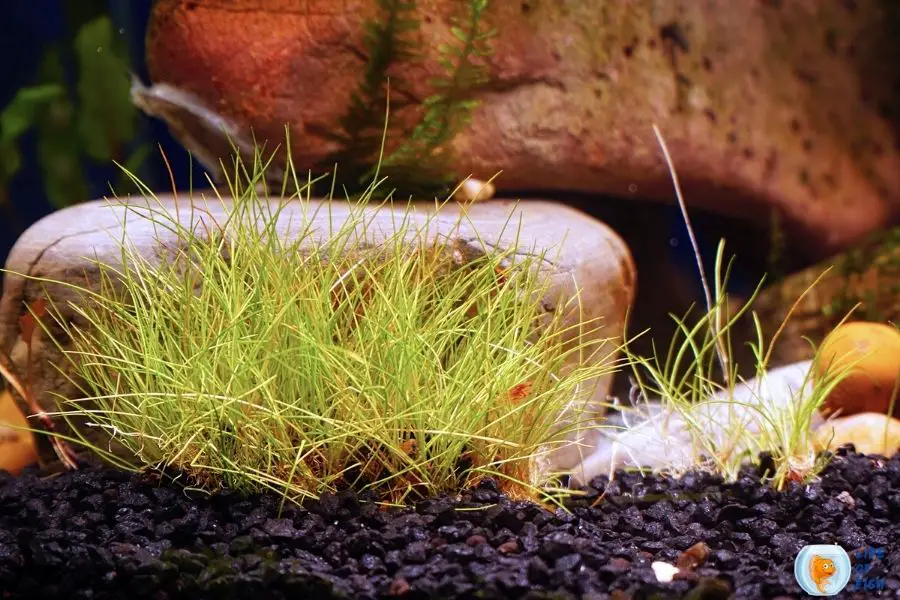
What is Eleocharis acicularis?
Jump To
- 1 What is Eleocharis acicularis?
- 2 How to identify?
- 3 Is Eleocharis acicularis easy to grow?
- 4 Appearance of this aquarium plant
- 5 Distribution & natural habitat
- 6 One look care guide
- 7 Aquarium care requirements
- 8 How to keep Eleocharis acicularis alive?
- 9 Eleocharis acicularis tankmates
- 10 Diseases and common problems, treatment
- 11 How to attach Eleocharis acicularis to driftwood/rocks/plastic/fabric?
- 12 Why Eleocharis acicularis turning brown?
- 13 Related questions
- 14 Conclusion
Eleocharis Acicularis or dwarf hairgrass is one of the two species of Dwarf hairgrass known in the aquarium industry.
It is popular as a carpet plant and belongs to the Cyperaceae family.
This freshwater plant is actually is an amphibious spike-sedge with long, grass-like stems.
The stems grow about 5- 6 inches in height and are thin and densely packed. dwarf hairgrass is an annual or perennial plant that can last for a very long time.
Further dwarf hairgrass is an undemanding aquatic plant, but it is popular in the aquarium trade because of its appealing appearance, fast-growing rate, and benefits.
How to identify?
It is relatively easy to identify this plant because of its grass-like appearance. Eleocharis Acicularis has long, grass-like stems rather than leaves.
These stems/strands are thin, densely packed, and pointed upwards for photosynthesis.
This plant grows short than other related species. Hence, the term “dwarf” is included in its common name.
When fully grown, the stems reach about 4 to 6 inches maximum. The color of Eleocharis Acicularis is light green. When exposed to lights, the plant gets a velvety look.
Is Eleocharis acicularis easy to grow?
Eleocharis Acicularis is an easy-to-grow plant. However, it needs proper planting and care to thrive.
It has specific lighting, fertilizers, substrate, and CO2 needs (which are easy to provide). If it gets ideal conditions, this plant will grow without problems.
Appearance of this aquarium plant
Appearance-wise, Eleocharis Acicularis has a green grass-like look with short, thin stems that are densely packed and pointed upwards.
These stems grow for about 4-6 inches in length and become brighter in bright lights.
They can grow into the dense carpet in a very short period of time. Therefore these plants use as foreground plants in aquariums.
Furthermore, dwarf hairgrasses are show similarities to some aquatic forms like Eleocharis parvula, E robbinsii, and Schoenoplecus subterminalis.
Apparently, dwarf hairgrass produced tiny flowers. These tiny flowers are less than five millimeters wide.
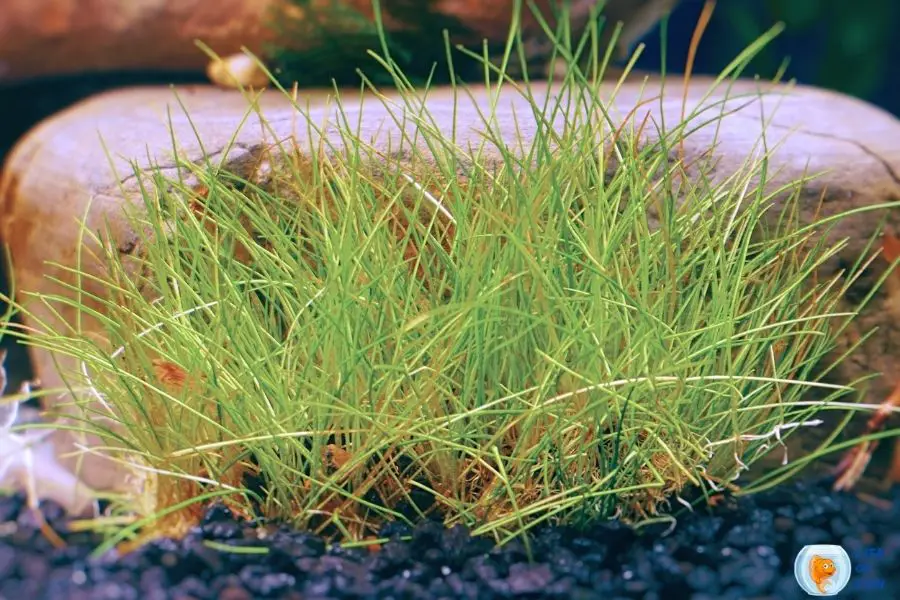
Distribution & natural habitat
Eleocharis Acicularis is a common Spikerushes found globally.
They are native to North America and distributed across Europe, central and southeastern Asia, North America, and northeastern South America.
It grows in wet meadows, muddy edges of pools and streams. It grows both submerged and emerged.
The dwarf hairgrass is also found in Australia and it can be introduced species there.
One look care guide
| Scientific name | Eleocharis acicularis |
| Family | Cyperaceae |
| Common name | Dwarf Hair Grass Needle Spikerush Needle-Spike Rush Hair Grass |
| Care level | Moderate |
| Reef compatible | No, Freshwater Plant |
| Native to | North America, Distributed worldwide |
| Placement | Foreground plant |
| Color | Green |
| Tank size | 10 Gallons |
| Preferred temperature | 50 and 83F |
| Other water parameters | pH level – 6.5 to 7.5 water hardness – 2 to 10 dKH |
| Lighting | Medium to High |
| Preferred salinity | No salinity |
| Size | 6 inches |
| Growth rate | Fast, 1 inch per month, about 2 inches per month with CO2 injection |
| Propagation | Runners |
| Recommended tank mates | Shrimps Snails Carnivore fish No uprooting fish No aggressive plant eaters |
Aquarium care requirements
Although this is an easy to care plant, Eleocharis Acicularis does require specific conditions to thrive.
Light condition
Eleocharis acicularis require medium to high levels of light to thrive. You have to provide about 10 to 14 hours of lights per day.
The ideal color temperature is between 5000 and 7000 Kelvins. The brighter the light, the longer this plant will live.
Fertilizers & substrates
Eleocharis acicularis require fertilizers to thrive. they are known as root feeders and you can use root tabs to feed them.
You should place the root tab between plants for better results.
You can use nutrient-rich substrate or liquid or powdered fertilizers to provide nutrients for this plant.
This plant can grow on both soil and sand. However, It is wise to use sand substrate because it is easy for the roots to push through.
You can also use a combination of substrates with sand on the top layer. About a 1.5-inch thick layer is enough.
Can Eleocharis acicularis grow on sand?
Yes. Sand is a popular choice as the substrate for this plant because it is the easiest to push the roots through.
If planted in the sand, Eleocharis acicularis easily send runners over sand and grow well if fertilizers are provided.
But keep in mind very fine sand or gravel is not suitable for their growth.
Water quality
Eleocharis acicularis is a freshwater plant. The optimum water temperature for this plant is between 50 and 83F, and the ideal pH level is 6.5 to 7.5.
The water hardness should be around 2 to 10 dKH.
Temperature
This plant can survive in a wide range of temperatures of between 50 and 83F. It can also tolerate cold waters, which is why this plant is distributed almost everywhere.
Placement
Eleocharis acicularis is an amphibious plant that can thrive either partially or fully submerged.
In an aquarium, you can use this plant as a foreground plant. It will form a carpet on the substrate, making a luscious green field.
CO2 requirment
Eleocharis acicularis do not require CO2 to thrive but will benefit from CO2 supplementation.
CO2 increases the plant’s growth rate. So, if you want the plant to grow fast, you can feed the plant with CO2 and fertilizers.
Can you float Eleocharis acicularis?
You can not float Eleocharis acicularis as it needs a substrate to establish its roots.
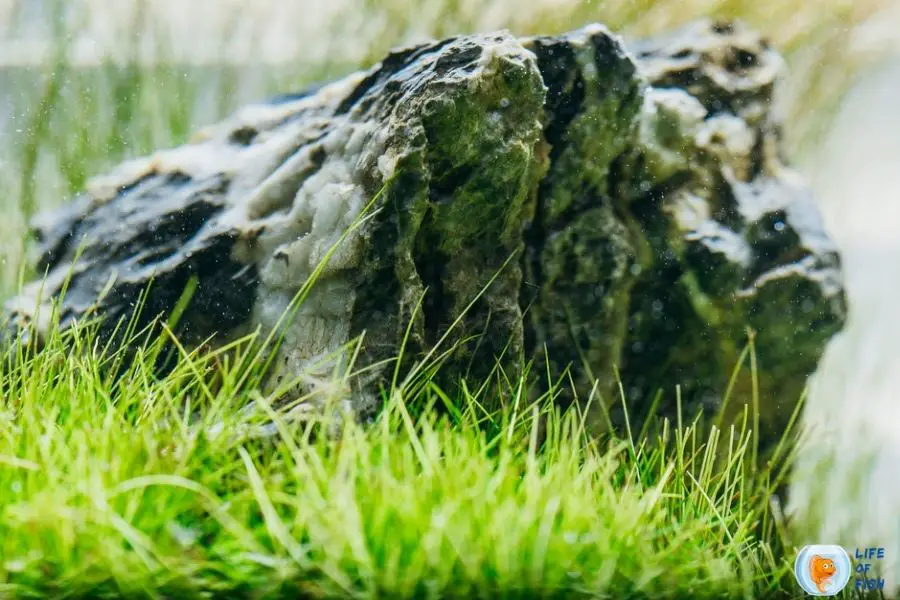
How to keep Eleocharis acicularis alive?
To keep Eleocharis acicularis alive, you need to provide proper lighting and nutrients. Otherwise, the plant may not grow as you expect, or in worse conditions, it may die.
How fast does Eleocharis acicularis grow?
This is a fairly fast-growing plant. It takes around six months to grow around 6 inches in height.
You can expect the plant to grow about 1 inch monthly, and if you provide bright light, fertilizers, and CO2, the growth rate will elevate by about 2 inches per month.
How to trim Eleocharis acicularis?
You can trim Eleocharis acicularis using angled scissors. Trimming is a lot like pruning a lawn with scissors.
But, you should keep a net along while cutting to take the trimmings out of the water column.
Still, some of those trimmings will bypass and may clog your filter. However, if you have a cleaning crew in your tank, this won’t be much of an issue.
Does Eleocharis acicularis need CO2?
CO2 injection is not required for this plant, but the plant definitely benefits from CO2 supplementation like any other aquatic plant.
By providing CO2, the plant will grow faster.
How do you propagate Eleocharis acicularis?
Propagation of Eleocharis acicularis is easy. You have to take out a clump of this plant and split it into the portions of 1-4 stems/blades.
Now carefully place the roots of these small portions in the substrate. Clipping the roots will facilitate the rapid growth of the carpet.
So, if possible, cut some existing roots before placing them.
Can Eleocharis acicularis grow out of water?
Eleocharis acicularis is an aquatic plant. So, this plant needs to be placed somewhere in the water.
Although this plant does well when partially submerged, you always have to keep it in an aquatic area of an enclosure. Therefore, it can not grow out of water.
Eleocharis acicularis tankmates
As Eleocharis acicularis have specific care needs, you should choose tankmates carefully.
Fish
It is a reasonably slow-growing plant. So, you should avoid fish that have uprooting habits, such as Dwarf Gouramis and Cichlids.
The fish with hefty appetites for plants also do not fit with this plant. For example, silver Dollars, Tetras, Goldfish, and Koi are well-known fish that destroy plants.
Suitable tankmates are small non-aggressive fish, carnivore fish, and omnivore fish that doesn’t have a strong appetite for plants.
Aquarium Plants
As Eleocharis acicularis require lights to thrive, you should not cover this plant with other plants.
It is used as a foreground plant, and you should provide dedicated lighting for this plant.
Any background or midground plant will be fine as long as they do not cover lights.
Other organisms
It is an excellent choice for shrimp and snail tanks. This plant provides shelter, hiding places, and breeding space for these species.
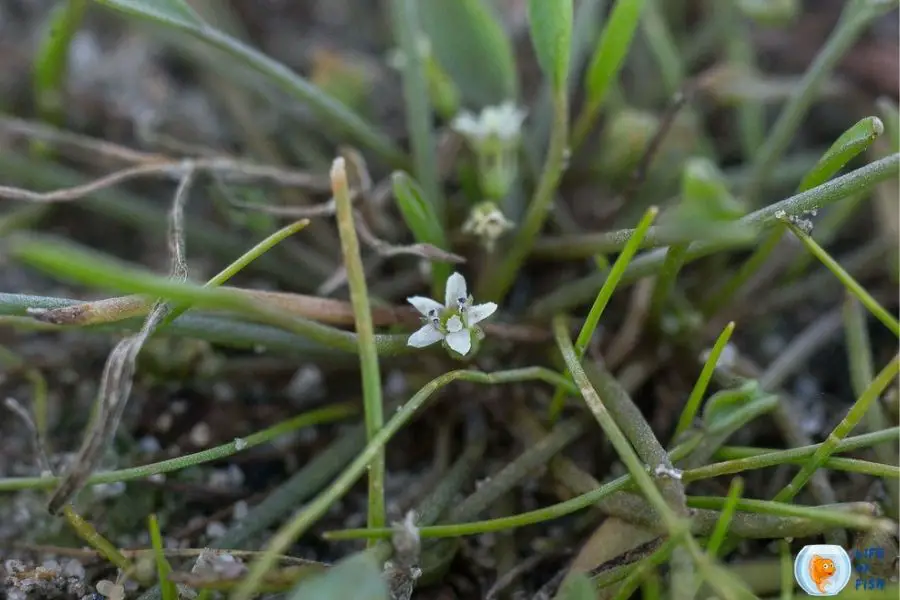
Diseases and common problems, treatment
Eleocharis acicularis is a disease-free plant when suitable conditions are met. This plant mainly requires fertilizers and light.
Failure to provide enough fertilizers and lights may cause plant malnourishment, toxic buildup, or excessive algae growth in the tank.
When the aquarium lacks enough CO2, the plant will turn brownish. So, therefore, you will have to inject CO2 for healthy growth.
How to attach Eleocharis acicularis to driftwood/rocks/plastic/fabric?
Eleocharis acicularis require a substrate to grow.
So, unless you find a way to place substrate on the surface of driftwood, rocks, plastic, or fabric, you won’t be able to attach it to these decorative items.
Therefore, it is solely used as a foreground plant.
Some hobbyists had little success in drilling the driftwood and placing this plant with some substrate around it.
But, the plant did not distribute around the driftwood as it didn’t have any more substrate.
Why Eleocharis acicularis turning brown?
It turns brown when it doesn’t get enough CO2.
Although this plant does not require CO2 in an aquarium as fish naturally produce CO2, other plant species may absorb this gas before Eleocharis acicularis does.
In that case, the aquarium runs out of enough CO2 for all the plant species. Therefore, you will have to supplement the plants with CO2 by injecting them.
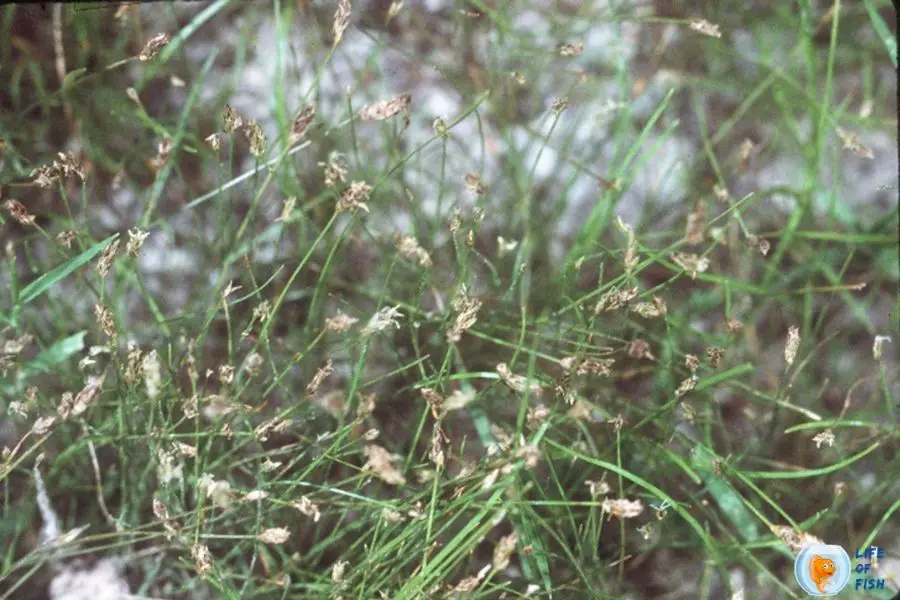
Related questions
Does Eleocharis acicularis mini need CO2?
Eleocharis acicularis mini doesn’t necessarily need CO2 to thrive but will definitely benefit from CO2 supplementation.
How do you plant Eleocharis acicularis in an aquarium?
In aquariums, it is used as a foreground plant. It will provide a nice and shiny grass-like look in your aquarium when it gets bright light and fertilizers.
Is Eleocharis acicularis dwarf hair grass?
Yes. it is one of the three species of Dwarf Hair Grass. Other two species are Eleocharis Parvula and Eleocharis Belem.
These three species share the same look, water conditions, and care. So, all three species are commonly known as Dwarf Hair Grass.
Conclusion
Eleocharis acicularis is an excellent carpeting plant for aquariums, ponds, bog gardens, waterfalls, and streams.
It is an easy to care plant as it is hardy and disease-free. If the requirements for lights and fertilizers are met, it will grow healthy without much care.
Therefore, they are considered beginner-friendly aquarium plants.
Read Next: Hygrophila Difformis in Aquarium | 11 Things You Must Know |

